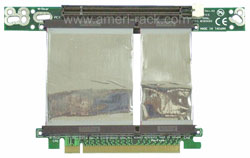Lets face it, the ATX motherboard layout was not designed for cooling GPUs, especially 300W GPUs, let alone FOUR 300W GPUs. In fact, the slot design of PCIE just plain sucks ass.
I have zero confidence that ATX will change to something useful any time soon (lol BTX) so I expect external GPUs will be the norm in a few years. Just imagine taking one of these out the back of the case to a box that has enough room for a cooler similar to the current CPU air coolers.
Yeah I know only the GTX 480 is hot as hell right now, but how soon until the slot design of ATX becomes a much bigger limiting factor to GPU design?

I have zero confidence that ATX will change to something useful any time soon (lol BTX) so I expect external GPUs will be the norm in a few years. Just imagine taking one of these out the back of the case to a box that has enough room for a cooler similar to the current CPU air coolers.
Yeah I know only the GTX 480 is hot as hell right now, but how soon until the slot design of ATX becomes a much bigger limiting factor to GPU design?

![[H]ard|Forum](/styles/hardforum/xenforo/logo_dark.png)